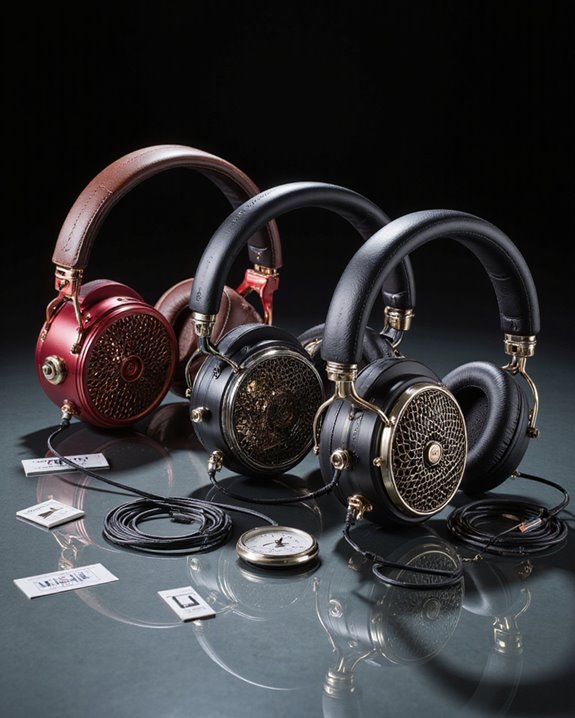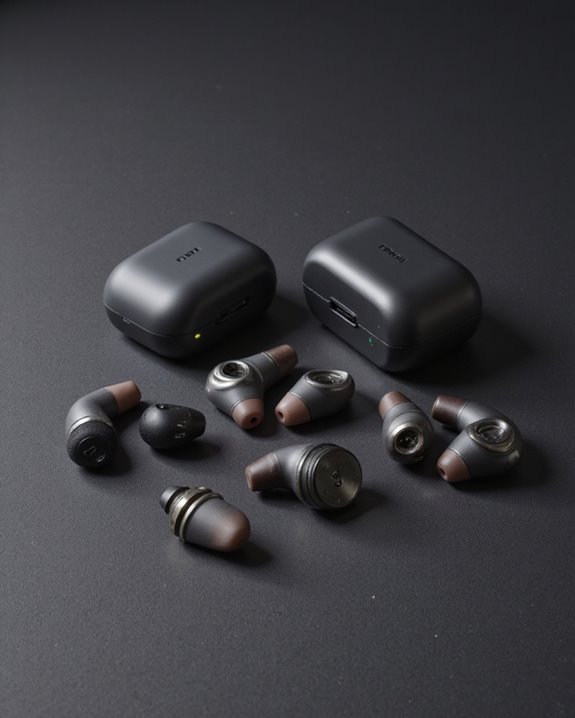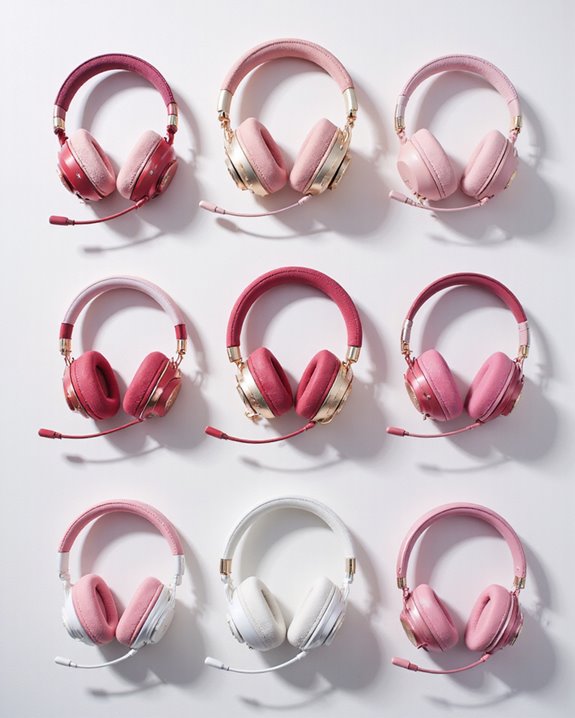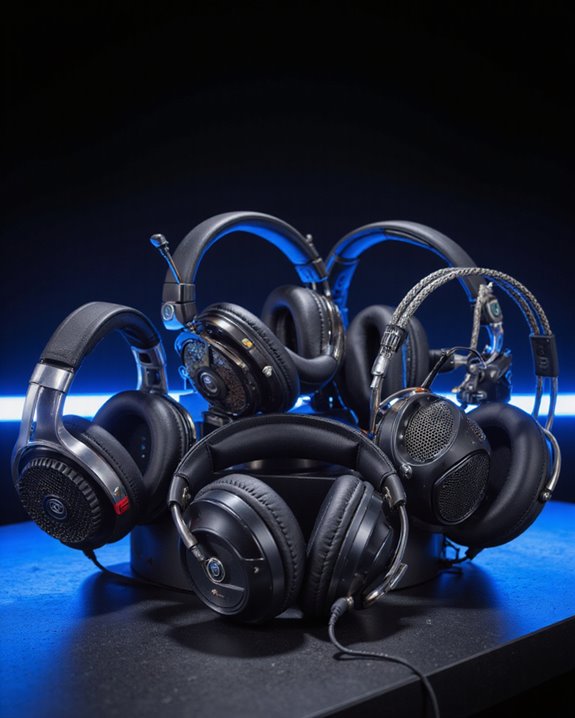As an Amazon Associate, we earn from qualifying purchases. Some links may be affiliate links at no extra cost to you. Although our opinions are based on curated research, we haven't used these products. Articles generated with AI.

The 3 Loudest Headphones of 2025 – Maximum Volume Without Compromising Quality
For maximum volume without distortion, you’ll find impressive sound pressure levels above 110 dB in the Beats Studio Pro, Bose QuietComfort, and Sennheiser HD 490 PRO Plus. The Beats Studio Pro delivers thunderous bass with 40-hour battery life, while the Bose QuietComfort offers adjustable EQ and superior noise cancellation. The Sennheiser HD 490 PRO Plus features precise audio localization through its open-back design. Understanding each model’s unique driver configurations and power handling capabilities reveals their full potential.
Key Takeaways
- Beats Studio Pro delivers maximum volume through dynamic drivers and 100dB/mW sensitivity while maintaining audio quality with studio-grade components.
- Large 40mm+ drivers combined with low impedance (16-32 ohms) enables louder output from portable devices without requiring additional amplification.
- Active noise cancellation up to 30dB enhances perceived loudness without increasing volume, preserving audio quality and protecting hearing.
- Over-ear designs with proper seal provide superior passive isolation, allowing higher volume levels while blocking external noise interference.
- High power handling above 100mW and Bluetooth 5.0+ ensure consistent loud playback without signal degradation or audio distortion.
Beats Studio Pro Wireless Bluetooth Noise Cancelling Headphones
Sale
Beats Studio Pro - Wireless Bluetooth Noise Cancelling Headphones - Personalized Spatial Audio,...
- BEATS' CUSTOM ACOUSTIC PLATFORM delivers rich, immersive sound whether you’re listening to music or taking calls.
- LOSSLESS AUDIO via USB-C plus three distinct built-in sound profiles to enhance your listening experience
- HEAR WHAT YOU WANT with two distinct listening modes: fully-adaptive Active Noise Cancelling (ANC) and Transparency mode
The Beats Studio Pro Wireless delivers an impressive 40 hours of battery life and thunderous bass-heavy sound that’ll satisfy audiophiles who demand both power and endurance.
You’ll experience studio-quality audio through its dynamic drivers and V-shaped sound signature, while the personalized Spatial Audio with head tracking creates an immersive 360-degree listening experience. The active noise cancellation effectively blocks distractions, and transparency mode keeps you aware of your surroundings when needed.
With Bluetooth 5.3’s 100-meter range and one-touch pairing for both Apple and Android devices, you’ll enjoy seamless connectivity. The USB-C lossless audio support and fast charging capability (4 hours of playback from a 10-minute charge) make these 260g headphones a versatile powerhouse.
Best For: Music enthusiasts and power users seeking premium wireless headphones with exceptional battery life, powerful bass, and versatile connectivity options across multiple devices.
Pros:
- Outstanding 40-hour battery life with quick charging capability
- Excellent sound quality with customizable profiles and spatial audio support
- Versatile connectivity options including Bluetooth 5.3, USB-C lossless audio, and 3.5mm jack
Cons:
- Not water resistant, limiting outdoor use in wet conditions
- Relatively heavy at 260g with high clamping force that may cause discomfort during extended wear
- Some users report wind noise issues during ANC mode
Bose QuietComfort Wireless Noise Cancelling Headphones
Bose QuietComfort Bluetooth Headphones, Wireless Headphones with Active Over Ear Noise Cancelling...
- NOISE CANCELLING HEADPHONES: Effortlessly combines noise cancellation technology with passive features so you can shut off the outside world, quiet distractions, and take...
- COMFORTABLE HEADPHONES: Plush earcup cushions softly hug your ears, while a secure and comfortable padded band gently keeps your over ear headphones in place for those...
- 2 LISTENING MODES: These wireless Bluetooth headphones feature Quiet and Aware Modes that let you toggle between full noise cancelling or full awareness of your...
Leading Bose’s lineup of premium audio gear, QuietComfort Wireless Noise Cancelling Headphones deliver exceptional sound quality while weighing just 238 grams, making them ideal for audiophiles who prioritize both performance and comfort during extended listening sessions.
You’ll experience impressive technical specs with a 20 Hz – 20,000 Hz frequency range and up to 24 hours of battery life. The adjustable EQ lets you fine-tune bass, mid-range, and treble, while multipoint Bluetooth 5.1 enables seamless switching between devices within a 10-meter range. The plush earcups and padded headband provide comfort during marathon listening sessions, complemented by advanced features like Wind Block mode and Spotify Tap integration.
Best For: Music enthusiasts and frequent travelers seeking premium wireless headphones with excellent noise cancellation, comfortable fit for long sessions, and sophisticated sound customization options.
Pros:
- Outstanding noise cancellation performance, especially effective for low-frequency sounds
- Comfortable design with plush earcups and lightweight construction (238g) suitable for extended wear
- Versatile connectivity with multipoint Bluetooth 5.1 and customizable EQ settings
Cons:
- Button placement and mapping can be confusing and non-intuitive
- Microphone quality falls short of expectations for voice calls
- Notable sound leakage may be problematic in quiet environments
Sennheiser HD 490 PRO Plus Openback Professional Headphone
Sennheiser HD 490 PRO Plus - Openback Professional Headphone w/Extra Cable, Earpads and Carry Case
- Open-back design with an extremely wide, dimensional sound stage and ultra-precise localization
- Uncolored frequency response for honest, dynamic sound reproduction across the full spectrum
- Sustainability-inspired with washable, replaceable pads and FSC-certified, forest-friendly packaging
Professional audio engineers and studio producers will find their ideal match in Sennheiser’s HD 490 PRO Plus, a German-engineered open-back headphone that delivers ultra-precise localization and uncolored frequency response.
You’ll experience a wide dimensional soundstage through the dynamic driver, which spans an impressive frequency range of 5 Hz to 36 kHz. The lightweight aluminum construction (2.5 pounds) guarantees comfort during extended mixing sessions, while two sets of interchangeable ear pads optimize your experience for both mixing and producing.
The package includes 1.8m and 3m cables, plus the dearVR MIX-SE plugin for enhanced studio work. With a 4.7-star rating from users, these headphones excel at vocal reproduction and pair exceptionally with professional audio equipment.
Best For: Professional audio engineers, music producers, and serious audiophiles seeking high-end studio monitoring headphones with precise sound reproduction and exceptional comfort for long mixing sessions.
Pros:
- Outstanding sound quality with ultra-precise localization and uncolored frequency response
- Versatile functionality with two sets of specialized ear pads for mixing and producing
- Premium build quality with German engineering and comfortable lightweight aluminum construction
Cons:
- Premium price point (implied by professional-grade positioning)
- Not water resistant, requiring careful handling in studio environments
- Open-back design means sound leakage, making them less suitable for public use or recording scenarios
Factors to Consider When Choosing the Loudest Headphones

When you’re searching for the loudest headphones, you’ll need to examine critical specifications like maximum sound output levels (measured in decibels), impedance ratings, and power handling capabilities. The physical characteristics, including driver size and type (dynamic, planar magnetic, or electrostatic), directly impact volume potential, while Bluetooth signal strength becomes essential for wireless models. Your choice should also factor in noise isolation features, as better-sealed headphones can achieve higher perceived loudness without requiring excessive power input.
Sound Output Maximum Level
Sound output capabilities serve as the cornerstone when evaluating headphones designed for maximum volume. When you’re searching for the loudest headphones, you’ll want to look for models that can reach 100-120 dB SPL, which represents the upper limit of consumer-grade options.
Sensitivity ratings play a vital role in determining output potential. You’ll find that headphones with sensitivity ratings above 100 dB/mW will deliver louder sound from your devices without requiring additional amplification. The driver size and type directly impact maximum volume – larger dynamic drivers typically offer more powerful output.
Consider your device compatibility through impedance ratings. If you’re planning to use your headphones with a smartphone, look for models with impedance below 32 ohms to achieve maximum volume. However, always prioritize safety features that limit exposure to dangerous sound levels above 85 dB.
Impedance and Power Requirements
The relationship between impedance and power requirements stands as an essential factor in achieving maximum volume from your headphones. When you’re looking for loud output, you’ll want to carefully match your headphones’ impedance to your device’s power capabilities.
Lower impedance headphones (16-32 ohms) will give you the highest volume levels on portable devices like smartphones and tablets. They don’t need much power to reach maximum loudness, making them ideal for everyday use.
If you’re considering high-impedance models (250+ ohms), you’ll need a dedicated amplifier or high-powered audio source. While these headphones can deliver exceptional sound quality, they won’t reach their full volume potential without proper amplification. Always check your device’s power output specifications in milliwatts (mW) to make sure it matches your headphones’ requirements.
Driver Type and Size
Driver specifications play a crucial role in determining how loud your headphones can get, with both type and size greatly impacting maximum volume potential. Dynamic drivers, in particular, excel at producing high sound pressure levels, making them a top choice when you’re seeking maximum volume.
Size matters greatly when it comes to driver capability. Larger drivers typically deliver more powerful bass response and convert electrical signals to sound more efficiently. You’ll find that bigger drivers often achieve higher volume levels from the same power input, thanks to their enhanced sensitivity.
When shopping for loud headphones, look for models featuring dynamic drivers in larger sizes (40mm or above). These configurations will give you the best combination of power handling and volume capability while maintaining sound quality across all frequencies.
Bluetooth Signal Strength
Powerful Bluetooth signal strength serves as a critical factor in achieving maximum volume output from wireless headphones. You’ll want to make sure your chosen headphones feature at least Bluetooth 5.0 or higher, as these versions deliver superior signal stability and range compared to older standards.
When examining signal specifications, look for Class 1 Bluetooth devices that offer up to 100-meter range in ideal conditions. However, keep in mind that real-world performance often differs due to obstacles and interference. For reliable audio performance, maintain RSSI levels above -70 dBm.
Pay attention to adaptive frequency hopping capabilities, as this feature helps maintain consistent signal strength by automatically switching frequencies to avoid interference. This technology becomes especially important when you’re using your headphones in areas with multiple wireless devices.
Noise Isolation Capabilities
Selecting headphones with superior noise isolation capabilities plays a crucial role in achieving maximum perceived loudness without damaging your hearing. You’ll want to look for models that combine both active and passive noise isolation technologies for best results.
The best performers will offer active noise cancellation that reduces ambient sounds by up to 30 decibels, while their passive isolation through sealed ear cups blocks frequencies from 20 Hz to 20 kHz. Together, these features can deliver up to 40 dB of total noise reduction.
For maximum isolation effectiveness, focus on over-ear designs rather than on-ear or open-back styles. When you’re comparing models, look for noise reduction ratings above 20 dB – this level of isolation guarantees you’ll get crystal-clear audio at lower, safer volume levels while blocking out unwanted external noise.
Frequently Asked Questions
Can Prolonged Use of High-Volume Headphones Cause Permanent Hearing Damage?
Even a short blast of thunderous sound can start permanent damage, but prolonged exposure to high-volume headphones will absolutely destroy your hearing over time. You’ll risk noise-induced hearing loss when you listen above 85 decibels for extended periods. Your inner ear’s delicate hair cells won’t regenerate once they’re damaged, and you’re likely to develop tinnitus (constant ringing) and difficulty understanding speech. Don’t risk your hearing health.
How Many Decibels Are Considered Safe for Extended Headphone Listening Sessions?
For safe headphone listening, you’ll want to follow the 60/60 rule: keep volume at or below 60% of maximum and limit sessions to 60 minutes. Generally, sounds under 85 decibels (dB) are considered safe for extended periods. However, you shouldn’t exceed 70-80 dB for daily headphone use. If others can hear your music when standing nearby, that’s a clear sign your volume is too high and potentially dangerous.
Which Headphone Brands Offer the Best Warranty for Volume-Related Defects?
Like a safety net for your audio investment, leading headphone warranties vary greatly when it comes to volume-related coverage. You’ll find Sony offers a robust 1-year warranty explicitly covering driver damage from high volumes, while Sennheiser provides 2 years of protection against volume-induced defects. Bose stands out with their extensive 2.5-year warranty that includes free replacement for any volume-related issues, though you’ll need to provide proof of normal usage patterns.
Are There Legal Volume Limitations for Headphones in Different Countries?
You’ll find that many countries enforce legal volume limits on headphones to protect consumers’ hearing. The European Union caps headphone volume at 85 decibels (dB) with a maximum override of 100 dB, while China enforces a strict 80 dB limit. In the United States, there aren’t federal regulations, but California requires warning labels on headphones that exceed 85 dB. Australia follows similar guidelines to the EU, limiting default volume to 85 dB.
Do Higher Volume Levels Drain Wireless Headphone Batteries Significantly Faster?
Like a thirsty engine burning more fuel at high speeds, your wireless headphones will drain battery faster at higher volumes. You’ll notice about 20-30% faster battery depletion when listening at maximum volume compared to moderate levels. This happens because the headphone amplifier needs more power to drive the speakers harder. Additionally, if you’re using active noise cancellation alongside high volume, you’ll see even greater battery drain due to the combined power demands.







